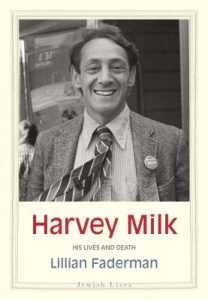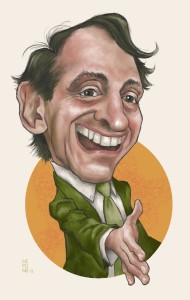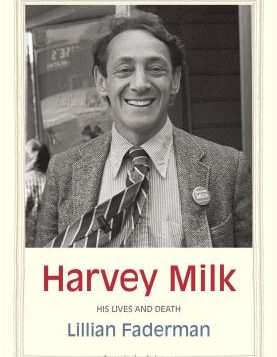 Harvey Milk: His Lives and Death
Harvey Milk: His Lives and Death
by Lillian Faderman
Yale Univ. Press. 305 pages, $25.
I WAS in my first semester at SUNY Plattsburgh on November 27, 1978, the day that ex-supervisor Dan White gunned down the mayor of San Francisco, George Moscone. I remember watching Moscone’s funeral on the news a few days later and being struck by the sight of his wife and many children following his casket. But to me this was just more craziness out of that wacky city, occurring just days after the Jim Jones’ People’s Temple mass suicide in Guyana. If I heard the name of another victim, it didn’t stick with me at the time. I came to know of Harvey Milk years later when I was coming out in full thrust and a friend invited me to watch The Times of Harvey Milk with him. History as I should have known it was all completely new to me; I was so moved by the documentary that I’ve been fascinated by Milk ever since, especially by what he could have been had he lived.
As Lillian Faderman’s new biography, Harvey Milk: His Lives and Death, reveals, Milk was not the first openly gay politician elected to public office, or even the first politician of significance to be out about his sexuality. But his theatricality at bringing about social change, as well as his bewildering death, pushed him to the forefront of national attention the way no other gay politician had been.
Faderman’s book is a warts-and-all chronology of Milk’s circuitous path to becoming a San Francisco board supervisor. Many themes emerge, not all of them flattering, which serves to remind us that every highly accomplished person is both extraordinary and flawed. On the positive side,  Milk was a populist of the best sort. He was also a showman to the very end, knowing how to dramatize political issues so that the otherwise disengaged would take notice of issues that affected their lives. In the negative column, according to Faderman, Milk had a “daddy savior complex” and was constantly tangled up with younger men who were self-destructive and, often, suicidal. The book is full of revelations, the most startling to me being Carol Ruth Silver’s miraculous escape from Dan White’s homicidal rage.
Milk was a populist of the best sort. He was also a showman to the very end, knowing how to dramatize political issues so that the otherwise disengaged would take notice of issues that affected their lives. In the negative column, according to Faderman, Milk had a “daddy savior complex” and was constantly tangled up with younger men who were self-destructive and, often, suicidal. The book is full of revelations, the most startling to me being Carol Ruth Silver’s miraculous escape from Dan White’s homicidal rage.
Other details develop the portrait of Harvey Milk as a short-lived civil rights martyr. He grew up in an especially anti-Semitic Long Island town with an angry, unhappy father and a mother who died in the cause of social justice. He was a political pariah in San Francisco before he was a star. He sparred with Moscone and Diane Feinstein and almost every other big player of his era. His camera store, Castro Camera, barely made him any money, but it became historic for its role as a locus of political organizing in San Francisco’s gay ghetto and for its association with politically driven gay social acceptance.
The book appears to be written for a young audience. Faderman refers to Milk by his first name throughout, and she invents internal dialogue (“What great theatre that would be, Harvey thought”). The prose is basic, sometimes even folksy: “Every word seemed to come directly from his heart”; “Gays did not need anyone speaking for them; they could speak very well for themselves.” This book might be particularly useful for inclusion in the Common Core, with its emphasis on nonfiction books. Faderman is a well-established chronicler of GLBT history and the author of more scholarly books, starting with her 1981 classic Surpassing the Love of Men: Romantic Friendship and Love between Women from the Renaissance to the Present. In the new book, while the prose is accessible for young readers, she does not hold back on specifics about sex and crime throughout.
While the murders are the dreaded climax of any story about Milk, Faderman has done some interesting examinations of Milk’s legacy, and she speculates about what might have happened had he lived beyond a year into his term. The book is part of the Jewish Lives Series (though its subject was clearly a secular rather than an observant Jew). The theme that comes through most prominently is Milk’s unflinching courage and forward-thinking resolution. I found myself frequently writing in the margins of my copy: “So ahead of his time.”
Peter Marino is an English professor at SUNY Adirondack in Queensbury, New York.






